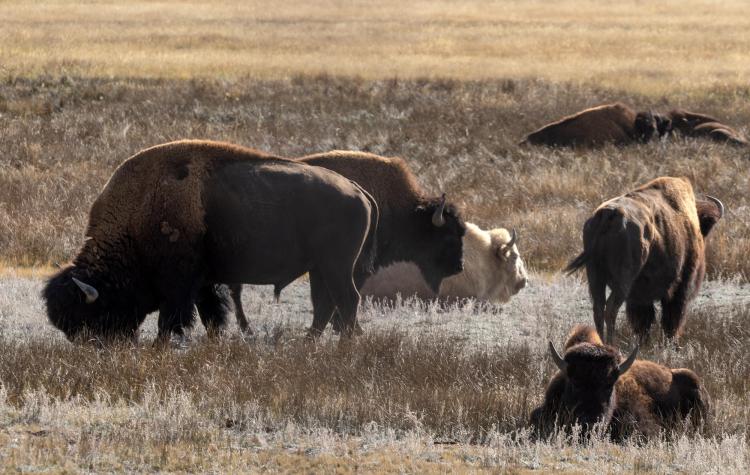What the White Buffalo Calf tells us about Indigenous history
Native Americans have been associated with bison in North America for more than 15,000 years
Road construction had closed Route 285 through South Park, detouring traffic to the eastern edge of the park. While inconvenient, it afforded people a sight that they would have missed otherwise. A herd of bison, Bison bison, was grazing next to the road, and in the herd were four white bison.
For more than 2,000 years, Lakota (Sioux) elders have been passing the legend of the White Buffalo Calf Woman to younger generations. The legend tells of a time when the Lakota had lost their ability to pray to the Creator. A young woman in shining white buckskin appeared to teach the people to pray during seven sacred rites, and she gave them the White Buffalo Calf Chanupa, or pipe, which played an important role in each of the rites. As she left, she told them that she would return to establish peace, harmony and balance.
Then she rolled on the earth four times, and each time she appeared as a buffalo of a different color (red and brown, then yellow, then black), finishing this display as a white buffalo calf. Today, the Sioux, Cherokee, Commanche and Navajo celebrate the birth of a white buffalo as a sacred omen indicating that their prayers had been heard and portending much better times.

White buffalo are more common today than 2,000 years ago when the legend of White Buffalo Calf Woman began. Photographed by Jeff Mitton.
Historically, white bison were rare, because they were probably albino (white hair, pink eyes), which occur at a frequency of about 1 in 10 million. But why are white bison so much more frequent now?
The herd in South Park had at least four, and white bison can be seen in three Canadian Territories and about a dozen states. The white bison in South Park have white hair but normally brown and black eyes. The gene for white hair was introduced from cows.
In the late 1800s and early 1900s, cattlemen attempted to cross bison with cows, hoping to gather the best traits from both species into one lineage as docile and manageable as domesticated cows. These experiments had unsatisfactory outcomes, but not before introducing genes from cows into bison.
One of the breeds of cattle in these experiments was Charcolais, which are all white. The gene (Charcolais SILV) producing white hair is recessive, meaning that two copies of the gene are needed to produce white hair. The gene influences hair color, but does not alter eye color. The white bison in South Park have dark eyes, so they most likely have two copies of Charcolais SILV.
Professional breeders would have no problem recovering a lineage of bison that breeds true for the Charcolais white hair, and indeed, herds of exclusively white bison with dark eyes can be found in Ohio, Oregon, Texas and Saskatchewan.
Similar phenotypes—albino vs. white hair produced by two copies of Charcolais SILV, present a conundrum to the Native Americans honoring the legend of White Buffalo Calf Woman. White bison calves are no longer rare.
Native Americans have been hunting bison for thousands of years, even before our contemporary bison evolved. The first of a series of species in the genus Bison migrated from Asia into Alaska via the Bering land bridge between 220,000 and 240,000 years ago.
The immigrant was B. priscus, an enormous animal with very long horns. The direct lineage of bison in North America began with B. priscus, followed by B. latifrons, then B. antiquus and finally our modern B. bison. From B. priscus to B. bison, both body size and horn length decreased.

According to the National Bison Association, one out of every 10 million births a white buffalo is born. Photographed by Jeff Mitton.
For example, large bull B. latifrons, B. antiquus and B. bison measured 8, 7 and 6 feet tall at the shoulder. B. latifrons went extinct 21,000 years ago, and B. antiquus disappeared 10,000 years ago, approximately the time that B. bison arose.
In the early 1900s, anthropologists thought that Native Americans had arrived in North America from Asia about 5,000 earlier, but B. antiquus provided a revelation for our history of Native Americans in North America. Shortly after a disastrous flood in New Mexico in 1908, a black cowboy named George McJunkin found large bison bones exposed by a new arroyo in Folsom, New Mexico.
This self-educated cowboy recognized that the bones came from a species much larger than B. bison. He shared his insight with others, and years later, when archeologists explored the site, they found the bones of 32 extinct B. antiquus and 26 spearheads unlike any that had been found previously.
Carbon dating indicated that these bison lived 12,000 years ago. The arroyo was once a marsh where B. antiquus were stalked by hunters wielding spears with spearheads now called Folsom points. This kill site provided unequivocal evidence that Native Americans had arrived in North America at least 7,000 years earlier than previously thought.
Subsequent to the discovery of Folsom points, Clovis points dating to 13,000 years ago have been found in mammoth kill sites at Clovis, New Mexico, and points dating to 15,500 years ago have been found at the Debra L. Friedkin site, a bison kill site near Dallas. Bison have inadvertently yielded considerable insight to Native American history.

